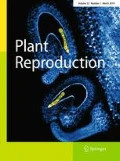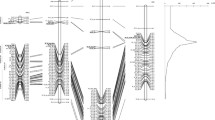Abstract
The sex segregation ratio was checked in bi-parental families of Actinidia deliciosa (2n=6x=174) obtained by crossing four females (A12, Mo3, Br4, Hw1) with two males (T2, M1) and one fruiting male (M3h, subandroecious) according to a factorial mating design. The M3h fruiting male was also selfed. The sex ratio was checked in maternal families of A. kolomikta (2n=2x) and A. chinensis (2n=2x) as well as in A. deliciosa. Seedlings of both diploid species took 3–4 years to progress beyond juvenility, whereas a noticeable number of seedlings from biparental crosses of A. deliciosa involving A12 and Hw1 as seed parents were still non-flowering after seven growing seasons. Open-pollinated families of both diploid and hexaploid species as well as most families from biparental crosses showed a sex segregation ratio approaching 1∶1. Subandroecious lines with different degrees of ovary and pistil development appeared in proportions of 0–4.2%, depending on the cross, but only 6 of the 2567 male vines checked were capable of setting fruit. No case of self-fertility or apomixis was detected among 1866 bagged female vines. Selfed M3h progenies gave only female and male phenotypes in a ratio of 1 female to 3 males. No off-type vines were found among these progenies. The same disomic sex segregation ratio seems to be operating at different ploidy levels in the genus Actinidia. Since selfed fruiting males produced both female and male individuals, the male sex appears to be the heterogametic one. Such evidence indicates that a monofactorial system based on one or more linked genes or on an X/Y chromosome set must be controlling sex expression. How a monofactorial sex-determining mechanism could operate in polyploids to give a 1∶1 female: male ratio is discussed. Minor modifying gene(s) seem to be responsible for the feminization of males, and their expression appears enhanced by environmental conditions. Masculinizing gene(s) seem to be lacking in female genotypes.
Similar content being viewed by others
References
Beatson RA (1991) Inheritance of fruit characters in Actinidia deliciosa. Acta Hortic 297:79–86
Blanchet P, Chartier J (1991) Genetic variability among the progeny of ‘Hayward’ kiwifruit. Acta Hort 297:87–92
Conn JS, Blum V (1981) Sex ratio in Rumex hastatulus: the effect of environmental factors and certation. Evolution 35:1108–1116
Dellaporta SL, Calderon-Urrea A (1993) Sex determination in flowering plants. Plant Cell 5:1241–1251
Ferguson AR (1984) Kiwifruit: a botanical review. Hortic Rev 6:1–64
Ferguson AR (1990) Kiwifruit (Actinidia). In: Moore JN, Ballington JR Jr (eds) Genetic resources of temperate fruit and nut crops. Acta Hortic 290:603–653
Ferguson AR, Seal AG, McNeilage MA, Fraser LG, Harvey CF, Beatson RA (1995) Kiwifruit. In: Janick J, Moore JN (eds) Fruit Breeding. Wiley, New York (in press)
Fraser LG, Harvey CF (1988) Preparation of protoplasts from microspore tetrads of kiwifruit, Actinidia deliciosa (Actinidiaceae). Sci Hortic 37:111–121
Hirsch AM, Fortune D, Blanchet P (1990) Study of dioecism in kiwifruit, Actinidia deliciosa Chevalier. Acta Hortic 282:367–376
McNeilage MA (1988) Cytogenetics, dioecism and quantitative variation in Actinidia. PhD Thesis, University of Auckland, New Zealand
McNeilage MA (1991a) Gender variation in Actinidia deliciosa, the kiwifruit. Sex Plant Reprod 4:267–273
McNeilage MA (1991b) Sex expression in fruiting male vines of kiwifruit. Sex Plant Reprod 4:274–278
McNeilage MA, Considine JA (1989) Chromosome studies in some Actinidia taxa and implications for breeding. N Z J Bot 27:71–81
Messina R (1993) Microsporogenesis in male-fertile cv. Matua and male-sterile cv. Hayward of Actinidia deliciosa var. deliciosa (kiwifruit). Adv Hortic Sci 7:77–81
Messina R, Vischi M, Marchetti S, Testolin R, Milani N (1990) Observations on subdioeciousness and fertilization in a kiwifruit breeding program. Acta Hortic 282:377–386
Seal AG, McNeilage MA (1989) Sex and kiwifruit breeding. Acta Hortic 240:35–38
Testolin R, Cipriani G, Costa G (1995) Estimate of variance components and heritability of characters in kiwifruit (Actinidia deliciosa). Acta Hortic (in press)
Westergaard M (1958) The mechanism of sex determination in dioecious flowering plants. Adv Genet 9:217–281
Xiong Z-T, Huang R-H (1988) Chromosome numbers of 10 species and 3 varieties in Actinidia Lindl. Acta Phytotaxon Sin 26:245–249
Xiong Z-T, Huang R-H, Wu X-W (1985) Observations on the chromosome numbers of 4 species in Actinidia. J Wuhan Bot Res 3:219–224
Yan G, Ferguson AR, McNeilage MA (1994) Ploidy races in Actinidia chinensis. Euphytica (in press)
Zhang J, Beuzenberg EJ (1983) Chromosome numbers in two varieties of Actinidia chinensis Planch. N Z J Bot 21:353–355
Author information
Authors and Affiliations
Rights and permissions
About this article
Cite this article
Testolin, R., Cipriani, G. & Costa, G. Sex segregation ratio and gender expression in the genus Actinidia . Sexual Plant Reprod 8, 129–132 (1995). https://doi.org/10.1007/BF00242255
Received:
Accepted:
Issue Date:
DOI: https://doi.org/10.1007/BF00242255




